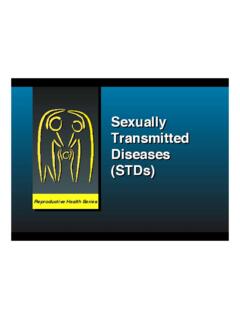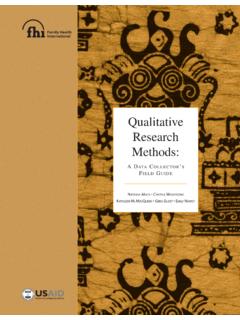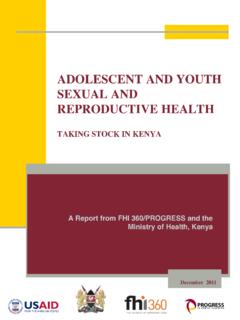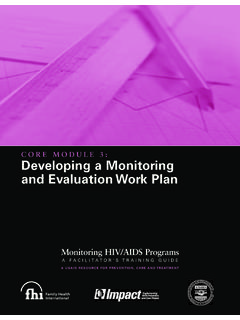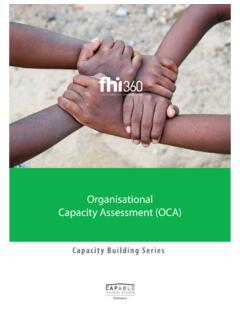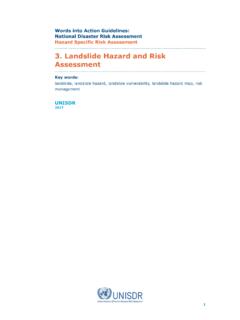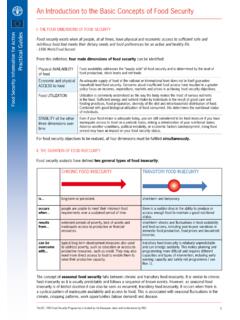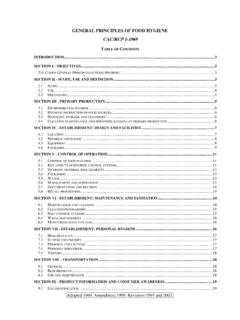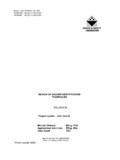Transcription of VULNERABILITY ?” This could be just one variable, or many ...
1 This brief was produced under United States Agency for International Development (USAID) Cooperative Agreement No. AID-OAA-LA-13-00001. The contents are the responsibility of FHI 360 and do not necessarily reflect the views of USAID or the United States Government. VULNERABILITY ASSESSMENT METHODS By Whitney Moret, ASPIRES May 2014 Introduction In the development community, VULNERABILITY has become an important concept used to guide the design, evaluation, and targeting of programs. In southern Africa, for instance, governments, NGOs, UN agencies, and other groups formed country-level VULNERABILITY Assessment Committees starting in 1999 to harmonize and improve methods of assessing VULNERABILITY , with a focus on food aid (Frankenberger, Mock, & Jere, 2005).
2 As the concept has matured, practitioners have given greater emphasis to the multidimensionality of VULNERABILITY , working with a variety of measures to capture its complexity. In this brief, we use the broad and established definition of VULNERABILITY in sustainability science as the degree to which a system, subsystem, or system component is likely to experience harm due to exposure to a hazard, either a perturbation or stress/stressor (Turner et al., 2003, p. 74). This brief reviews the different methods of assessing VULNERABILITY within the sector of economic strengthening. VULNERABILITY IN ECONOMIC STRENGTHENING The concept of VULNERABILITY has emerged across various disciplines, ranging from engineering to psychology, and its definition varies accordingly.
3 However, most of the literature characterizes VULNERABILITY according to the basic formula: Risk + Response = VULNERABILITY , or, as articulated in Holzmann et al. s guidelines on the Household Economy Approach (2008), Baseline + Hazard + Response = Outcome (v). The definition of risk will depend on the purpose of conducting a VULNERABILITY assessment and the definition of VULNERABILITY . In order for VULNERABILITY analysis to be useful, it is helpful to begin with the question, Vulnerable to what? This could be just one variable, or many variables. Several VULNERABILITY frameworks, discussed in the next section, provide a systematic understanding of VULNERABILITY dynamics that can be used to identify specific risks.
4 The response variable, or means of coping with a risk, is understood across these frameworks through the lens of sustainable livelihoods. Chambers and Conway s oft-cited definition states that: A livelihood comprises the capabilities, assets (stores, resources, claims and access) and activities required for a means of living: a livelihood is sustainable which can cope with and recover from stress and shocks, maintain or enhance its capabilities and assets, and provide sustainable livelihood opportunities for the next generation; and which contributes net benefits to their livelihoods at the local and global levels and in the short and long term" (1991:6).
5 The sustainable livelihoods framework is influenced by the work of economist Amartya Sen, whose conception of entitlements laid the ground-work for asset-based analysis focused on livelihoods (Alwang, Siegel, & J rgensen, 2001). Assets include items such as labor, human capital, housing, household relations, and social capital (Moser, 1998). All of these items contribute to a household s means of coping with risk. Hoddinott and Quisumbing (2003) pose five questions that a VULNERABILITY assessment should ultimately answer (p. 46): 1) What is the extent of VULNERABILITY ? 2) Who is vulnerable? 3) What are the sources of VULNERABILITY ?
6 4) How do households respond to shocks? 5) What gaps exist between risks and risk management mechanisms? 2 VULNERABILITY Assessment Methods Ultimately, selecting VULNERABILITY assessment methods will depend on the purpose and focus of the VULNERABILITY assessment. This will also affect the level of analysis required. Population level measures, used to segment a population into different categories of VULNERABILITY , are useful for policy, planning, and project design. When used with participative methods, they can also be useful for community mobilization. For project targeting, household level methods will be required. MEASURES USED FOR POLICY AND PROJECT PLANNING AND STRATEGY This section features VULNERABILITY assessment approaches used to create a comprehensive baseline for analysis based on population level data.
7 They provide overall guidelines for assessing VULNERABILITY from the macro to micro levels, for both segmenting the population by levels of VULNERABILITY and targeting individuals or households. They employ mixed methods and tend to be resource intensive, requiring large amounts of data in order to capture the complexity of VULNERABILITY . Household Economy Approach (HEA) Overview: The Household Economy Approach is a livelihoods-based analytical framework developed by Save the Children UK in the early 90s designed to obtain information on how people access food and cash based on multi-level analysis (Lawrence et al., 2008). Amartya Sen s work on famines is a strong influence on the framework (Sen, 1981).
8 Sen argued that famines do not emerge simply from food shortages, but that underlying systems of inequality prevent certain groups from accessing food. The HEA seeks to understand these systems and set a baseline measure for livelihoods under normal conditions to better predict how they are affected by shocks. HEA uses mixed methods, which can include analysis of secondary data, quantitative primary data, and participatory and qualitative approaches. Used For: HEA is primarily used to predict the impact of national-level shocks and disasters across different wealth groups, seeking to answer the following questions: Where is assistance needed, and of what type?
9 Who needs it? How much is needed, when and for how long? (Lawrence et al. , 2008, ch. 1 ). 3 Selecting VULNERABILITY Assessment Methods 4 It was initially developed to provide large-scale ( national) predictions of food emergencies, but has since been adapted to assess an array of shocks (Petty & Seaman, 2004, p. 10) and is used by most National VULNERABILITY Assessment Committees in southern Africa (SADC FANR VULNERABILITY Committee, 2004). Pros and Cons: HEA provides rich, comprehensive baseline information. However, it can also be resource intensive. Unless modified using the Individual Household Model (IHM), HEA data does not reach the household level.
10 It is therefore more appropriate for large-scale segmentation across defined VULNERABILITY categories. Individual Household Model (IHM): The Individual Household Model (IHM) is a disaggregated version of HEA designed to provide more detailed VULNERABILITY analysis at the household level (Holzmann et al., 2008). Though it operates according to the same framework as HEA, IHM employs different field methods. Instead of interviewing individual households as representatives of a larger wealth group, IHM utilizes semi-structured interviews with individual households selected using statistical sampling methods. Another difference is that the results of IHM analysis are expressed in terms of household disposable income rather than access to food and other resources (Petty & Seaman, 2004).

